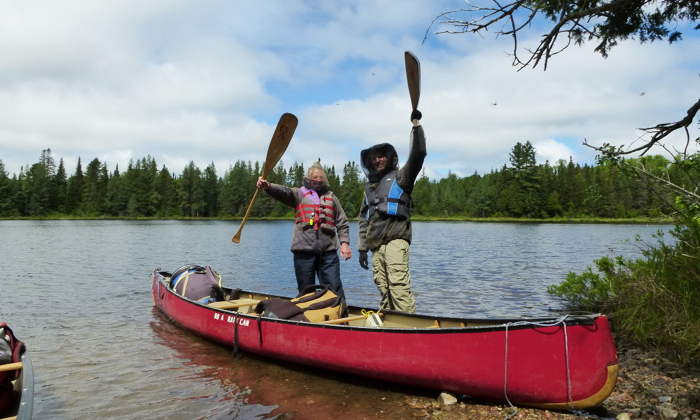
Three months ago, I didn’t know who Tom Thomson was. I’ve been so caught up ticking off the country’s Bucket List that a few (OK, more than a few) cultural icons slipped through the cracks. I had heard of the Group of 7, but figured everyone was talking about some kind of golden-era hockey team. Then I planned a visit to Algonquin Provincial Park, began to do my research, and discovered just how important art was in terms of defining Canada’s cultural identity. I also learned about a strange duck named Tom son of Tom son of Tom, who’s potential greatness was cut short with his mysterious drowning in the waters of Canoe Lake. Not so mysterious any more, because I know exactly what happened. Sort of. Maybe.
But first, the background, according to me. Turn of the 20th century Canada, a great northern outpost of the British Empire, is struggling to define itself. “We’re Not Australia” simply won’t cut it. The horrors of the first world war (you know, the one that was supposed to end all wars) are fresh. Artists looks to Europe for inspiration. But in Ontario there lived a man named Tom who loved the lakes, rivers and wilderness of a place called Algonquin. He worked as a ranger and a guide, and loved to paint what he saw. His day job back in Toronto was for a graphic design firm called Grip. He convinced his artist work pals that they too should visit Algonquin, and at some point the group decided to screw Europe and start expressing themselves in a Canadian fashion: Canadian artists painting Canadian landscapes. At the time, this was very controversial.
Thomson would disappear into the woods for weeks at a time, portaging his canoe into the thicket, bugs be damned, recording epic skies and forests and lakes with thick paint on small canvases. Now Algonquin is known for its characters – tough eccentric settlers, cabin people, woodsy folk. Thomson was well-known and relatively well-liked, staying at various lodges in the park. He was an expert outdoorsman, swimmer, survivalist. One day he disappeared. A few days later, his body was found floating in Canoe Lake. He had fishing twine tightly wrapped around his leg, and a blow to his temple. His paddle was never found. It could have been an accident. Anyone can slip, bump their head, drown. But then they would have found the paddle. It could have been suicide, except Thomson had just started selling his art to the National Gallery, had the world to live for, and wasn’t suicidal in the slightest. It was most likely murder. But in a slapdash attempt to avoid any controversy in an area courting tourism, the incident was quickly covered up by local authorities as an accident, albeit one with more questions than answers.
Not long after, Thomson’s pals back home held an exhibition and called themselves the Group of 7. They become very, very famous, and their works depicting the natural beauty of Ontario and elsewhere became instrumental in helping Canadians define what Canada actually is. They all paid tribute to Tom, who would have been in the Group had he not died. In the century since, there’s been several books, documentaries, movies, and many articles about Thomson. He left hundreds of paintings behind, and his work showed a steep learning curve of someone who took his art, and his nature, very seriously. Any visit to Algonquin should be followed or preceded by a visit to the McMichael Gallery in Kleinburg outside Toronto. Here you can see works by Thomson and the Group of 7, all of which do a wonderful job depicting the colours and under-the-skin beauty of the park. But what exactly happened to Thomson? Since you’re asking…
After many hours of reading and a few less conspiracy theorizing, I know for a fact* that Thomson was murdered, and I know by whom. Admittedly, the motive is still a little sketchy, but then motives usually are. Are you ready for it? Tom Thomson was murdered by his friend Shannon Fraser, who struck a blow to his temple with Thomson’s own paddle. In panic, he paddled with the body out on Canoe Lake, affixed wire around the leg to something heavy, and faked an accidental drowning. He then burned the paddle. When Thomson’s body eventually surfaced, Fraser immediately spread rumours that it was suicide (in retrospect, probably the most incriminating thing he could have done). Fraser was never investigated, he lived and died, although many years later his wife admitted much of the above to a friend. Various reports show area locals claiming they knew who did it, providing a not-so-subtle hint of someone matching Fraser’s description. The murder took place because a: Fraser owed Thomson money and couldn’t pay b: they had a drunken argument and it was an accident (most likely) c: Fraser thought Thomson, a known womanizer, was messing around with his wife d: Fraser was told to rough up Thomson because he had got a local girl pregnant e: A dark, baritone voice emerged from a bullfrog and told him to kill kill kill (least likely).
There you have it. A true Canadian mystery solved (maybe). Now you can visit Algonquin without the spectre of murder in the air, and focus on the important bits, namely the water, the views, the canoeing, the wildlife, the stars, the adventure. Contact the folks at Voyageur Quest if you’re interested, they took great care of us. Thomson was 39 years-old when he died in Algonquin. I was 39 years-old when I lived in it. Coincidence? Probably. But we’ll leave that mystery for another day.
* In the subjective tense.
